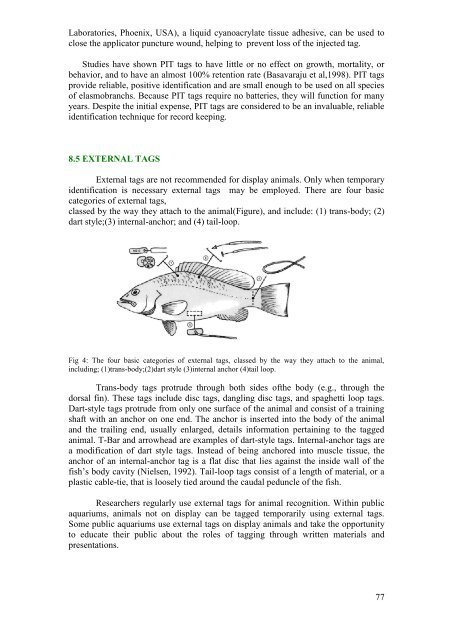standardization of records keeping in indian zoos - Central Zoo ...
standardization of records keeping in indian zoos - Central Zoo ...
standardization of records keeping in indian zoos - Central Zoo ...
You also want an ePaper? Increase the reach of your titles
YUMPU automatically turns print PDFs into web optimized ePapers that Google loves.
Laboratories, Phoenix, USA), a liquid cyanoacrylate tissue adhesive, can be used to<br />
close the applicator puncture wound, help<strong>in</strong>g to prevent loss <strong>of</strong> the <strong>in</strong>jected tag.<br />
Studies have shown PIT tags to have little or no effect on growth, mortality, or<br />
behavior, and to have an almost 100% retention rate (Basavaraju et al,1998). PIT tags<br />
provide reliable, positive identification and are small enough to be used on all species<br />
<strong>of</strong> elasmobranchs. Because PIT tags require no batteries, they will function for many<br />
years. Despite the <strong>in</strong>itial expense, PIT tags are considered to be an <strong>in</strong>valuable, reliable<br />
identification technique for record <strong>keep<strong>in</strong>g</strong>.<br />
8.5 EXTERNAL TAGS<br />
External tags are not recommended for display animals. Only when temporary<br />
identification is necessary external tags may be employed. There are four basic<br />
categories <strong>of</strong> external tags,<br />
classed by the way they attach to the animal(Figure), and <strong>in</strong>clude: (1) trans-body; (2)<br />
dart style;(3) <strong>in</strong>ternal-anchor; and (4) tail-loop.<br />
Fig 4: The four basic categories <strong>of</strong> external tags, classed by the way they attach to the animal,<br />
<strong>in</strong>clud<strong>in</strong>g; (1)trans-body;(2)dart style (3)<strong>in</strong>ternal anchor (4)tail loop.<br />
Trans-body tags protrude through both sides <strong>of</strong>the body (e.g., through the<br />
dorsal f<strong>in</strong>). These tags <strong>in</strong>clude disc tags, dangl<strong>in</strong>g disc tags, and spaghetti loop tags.<br />
Dart-style tags protrude from only one surface <strong>of</strong> the animal and consist <strong>of</strong> a tra<strong>in</strong><strong>in</strong>g<br />
shaft with an anchor on one end. The anchor is <strong>in</strong>serted <strong>in</strong>to the body <strong>of</strong> the animal<br />
and the trail<strong>in</strong>g end, usually enlarged, details <strong>in</strong>formation perta<strong>in</strong><strong>in</strong>g to the tagged<br />
animal. T-Bar and arrowhead are examples <strong>of</strong> dart-style tags. Internal-anchor tags are<br />
a modification <strong>of</strong> dart style tags. Instead <strong>of</strong> be<strong>in</strong>g anchored <strong>in</strong>to muscle tissue, the<br />
anchor <strong>of</strong> an <strong>in</strong>ternal-anchor tag is a flat disc that lies aga<strong>in</strong>st the <strong>in</strong>side wall <strong>of</strong> the<br />
fish‟s body cavity (Nielsen, 1992). Tail-loop tags consist <strong>of</strong> a length <strong>of</strong> material, or a<br />
plastic cable-tie, that is loosely tied around the caudal peduncle <strong>of</strong> the fish.<br />
Researchers regularly use external tags for animal recognition. With<strong>in</strong> public<br />
aquariums, animals not on display can be tagged temporarily us<strong>in</strong>g external tags.<br />
Some public aquariums use external tags on display animals and take the opportunity<br />
to educate their public about the roles <strong>of</strong> tagg<strong>in</strong>g through written materials and<br />
presentations.<br />
77
















